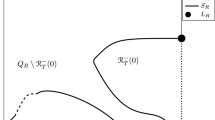Abstract
We prove a quantitative rate of homogenization for the G equation in a random environment with finite range of dependence. Using ideas from percolation theory, the proof bootstraps a result of Cardaliaguet–Souganidis, who proved qualitative homogenization in a more general ergodic environment.

Similar content being viewed by others
References
Alexander, K.S.: Approximation of subadditive functions and convergence rates in limitingshape results. Ann. Probab. 25(1), 30–55 (1997). https://doi.org/10.1214/aop/1024404277
Armstrong, S., Cardaliaguet, P., Souganidis, P.: Error estimates and convergence rates for the stochastic homogenization of Hamilton–Jacobi equations. J. Am. Math. Soc. 27(2), 479–540 (2014). https://doi.org/10.1090/S0894-0347-2014-00783
Barles, G.: Solutions de viscosité des équations de Hamilton–Jacobi, vol. 17. Springer, New York (1994)
Burago, D., Ivanov, S., Novikov, A.: Feeble fish in time-dependent waters and homogenization of the G-equation. Commun. Pure Appl. Math. 73(7), 1453–1489 (2020). https://doi.org/10.1002/cpa.21878
Capuzzo-Dolcetta, I., Ishii, H.: On the rate of convergence in homogenization of Hamilton–Jacobi equations. Indiana Univ. Math. J. 50(3), 1113–1129 (2001)
Cardaliaguet, P., Nolen, J., Souganidis, P.E.: Homogenization and enhancement for the G-equation. Arch. Ration. Mech. Anal. 199(2), 527–561 (2011). https://doi.org/10.1007/s00205-010-0332-8
Cardaliaguet, P., Souganidis, P.E.: Homogenization and enhancement of the G-equation in random environments. Commun. Pure Appl. Math. 66(10), 1582–1628 (2013). https://doi.org/10.1002/cpa.21449. (ISSN: 1097-0312.)
Cooperman, W. On the random G equation with nonzero divergence. arXiv:2204.04124 [math] (2022)
Deuschel, J.-D., Pisztora, A.: Surface order large deviations for high-density percolation. Probab. Theory Relat. Fields 104(4), 467–482 (1996). https://doi.org/10.1007/BF01198162. (ISSN: 1432-2064.)
Dugundji, J.: Topology. Allyn and Bacon Series in Advanced Mathematics. Allyn and Bacon, Boston (1966)
Fekete, M.: Über die Verteilung der Wurzeln bei gewissen algebraischen Gleichungen mit ganzzahligen Koeffizienten. Math. Z. 17(1), 228–249 (1923). https://doi.org/10.1007/BF01504345
Grinberg, V.S., Sevastyanov, S.V.: The value of the Steinitz constant Russian. Funk. Anal. Prilozh. 14, 56–57 (1980)
Kesten, H.: On the speed of convergence in first-passage percolation. Ann. Appl. Probab. 3(2), 296–338 (1993). https://doi.org/10.1214/aoap/1177005426
Kuratowski, K.: Topology: Volume II. v. 2. Elsevier Science (2014). ISBN: 9781483271798
Lions,G. Papanicolaou P.-L., Varadhan, S.R.S.: Homogenization of Hamilton–Jacobi equations (1987)
Matoušek, J.: Thirty-Three Miniatures: Mathematical and Algorithmic Applications of Linear Algebra. American Mathematical Society, Providence (2010)
Nolen, J., Novikov, A.: Homogenization of the G-equation with incompressible random drift in two dimensions-English (US). Commun. Math. Sci. 9(2), 561–582 (2011). https://doi.org/10.4310/CMS.2011.v9.n2.a11
Souganidis, P.E.: Stochastic homogenization of Hamilton–Jacobi equations and some applications. Asymptot. Anal. 20(1), 1–11 (1999). (ISSN: 09217134)
Tran, H.: Hamilton–Jacobi Equations: Theory and Applications. American Mathematical Society, Providence (2021)
Tran, H.V., Yu, Y: Optimal convergence rate for periodic homogenization of convex Hamilton–Jacobi equations. arXiv:2112.06896 [math] (2022)
William, M., Feldman, Souganidis, P.E.: Homogenization and non-homogenization of certain non-convex Hamilton–Jacobi equations. J. Math. Appl. 108(5), 751–782 (2017). https://doi.org/10.1016/j.matpur.2017.05.016. (ISSN: 0021-7824)
Ziliotto, B.: Stochastic homogenization of nonconvex Hamilton–Jacobi equations: a counter example. Commun. Pure Appl. Math. 70(9), 1798–1809 (2017). https://doi.org/10.1002/cpa.21674. (ISSN: 1097-0312)
Acknowledgements
I would like to thank my advisor, Charles Smart, for suggesting the problem and many helpful conversations. I would also like to thank Panagiotis Souganidis for suggesting the problem of continuous dependence of the Hamiltonian on the law of the environment.
Author information
Authors and Affiliations
Corresponding author
Additional information
Publisher's Note
Springer Nature remains neutral with regard to jurisdictional claims in published maps and institutional affiliations.
Appendix A. Proof of Theorem 3.3
Appendix A. Proof of Theorem 3.3
Step 1. We show that if \(x \in {\mathbb {Q}}^d\) with \(|x| \ge C\), then there is \(\alpha \in [c, 1]\) such that \(\alpha x\) lies in the convex hull of \(G_x\). Let \(n \in {\mathbb {N}}\) be large enough so that
Let \(x_0, x_1, \dots , x_m\) be an \(G_x\)-skeleton for nx. Then
and \(n \le m \le Cn\), where the first part of the inequality follows from applying \({\overline{f}}_x\) to both sides of the equation.
Step 2. We show that if \(x \in {\mathbb {Q}}^d\), \(|x| \ge K\), \(t \ge 1\), and \(tx \in {\mathbb {Z}}^d\), then there is a \(z \in {\mathbb {Z}}^d\) with \(f(tx) - {\overline{f}}(tx) \le f(z) - {\overline{f}}(z) + tC|x|^\nu \varphi (|x|)\). Using the previous step, write \(tx = z + \sum _{k=1}^m v_k\), where \(|z| \le C|x|\), \({\overline{f}}(z) \le {\overline{f}}_x(z) + C\), \(v_k \in G_x\), and \(m \le Ct\). Indeed, for some \(\alpha \in [c, 1]\) we first write
where \(v_i \in G_x\) and \(p_i \ge 0\), \(\sum _i p_i = 1\). Note that the sum only requires \(d+1\) terms by Caratheodory’s theorem on convex hulls, since we are working in \({\mathbb {R}}^d\). To decompose tx, we write
so z satisfies the required properties. By subadditivity of f and linearity of \({\overline{f}}_x\),
Finally, we write \({\overline{f}}(tx) = {\overline{f}}_x(z) + {\overline{f}}_x(tx-z)\) and subtract from both sides of the inequality above to get
where we used the fact that \({\overline{f}}(z) \le \overline{f_x}(z) + C\).
Step 3. For some large \(M > 1\) (and possibly enlarged K), the previous step yields
where we made C larger in the second line to account for the change in constant. By induction on k, we conclude that
Rights and permissions
Springer Nature or its licensor (e.g. a society or other partner) holds exclusive rights to this article under a publishing agreement with the author(s) or other rightsholder(s); author self-archiving of the accepted manuscript version of this article is solely governed by the terms of such publishing agreement and applicable law.
About this article
Cite this article
Cooperman, W. Quantitative stochastic homogenization of the G equation. Probab. Theory Relat. Fields 186, 493–520 (2023). https://doi.org/10.1007/s00440-022-01175-4
Received:
Revised:
Accepted:
Published:
Issue Date:
DOI: https://doi.org/10.1007/s00440-022-01175-4




